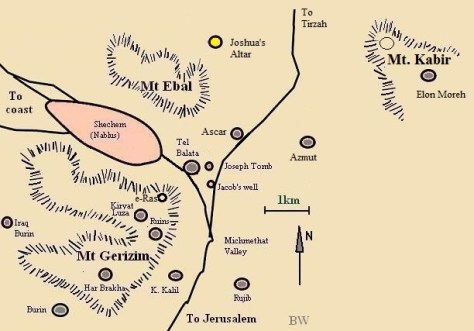Mount Ebal Curse Tablet Deciphered

Could Israel’s presence in the land of Canaan be dated earlier than many scholars have thought? Could the account of the building of an altar on Mount Ebal by Joshua mentioned in Joshua 8:30 be substantiated? Could it be possible that Moses did possess an alphabet enabling him to do the writing the Torah claims he did? All of these questions are raised by the decipherment of the Mount Ebal curse tablet. In a startling announcement this past Thursday ( March 24th, 2022), Scott Stripling, an archaeologist with Associates for Biblical Research (ABR), and provost of the Bible Seminary in Katy, Texas, revealed the contents of a curse tablet discovered on Mount Ebal in 2019. If the date of this tablet, currently placed in the Late Bronze Age (1400-1200 B.C.), and it’s translation are confirmed, it will be considered the greatest archaeological discovery in Israel of the 21st century.
The Significance of Mount Ebal

According to Deuteronomy 27:1-8, Moses commanded the Israelites upon entering the land to go to Mount Ebal. There they were to build an altar. Six of the tribes were to stand on Mount Ebal and pronounce the curses of the Law, while the other six tribes were to stand opposite on Mount Gerazim and pronounce the blessings of the Law. Joshua 8:30-35 records the obedience of Joshua and the Israelites who do as Moses commanded. (For more on the significance of this area, particularly ancient Shechem, see my article here).
Mount Ebal, Adam Zertal, and Joshua’s Altar

The backstory to the current discovery involves a survey of the area in 1980, by Israeli archaeologist Adam Zertal who also excavated at Mount Ebal from 1982-1989 (see Bible History Daily). Zertal believed that he had uncovered Joshua’s altar. This altar was dated to Iron Age I by Zertal (1200-1000 B.C.). However, there is an earlier altar that is covered by the larger altar. It is this earlier altar that Stripling and his team believes to be Joshua’s altar. This altar dates to the Late Bronze Age, the same age as the Mount Ebal curse tablet.

Discovery of the Mount Ebal Curse Tablet
In December 2019-January 2020, Stripling and his team received permission and funds to wet sift the archaeological dumps from Zertal’s excavation. Stripling had learned from working at the Temple Mount sifting project (see my article here), as well as at Shiloh, the current site he is excavating with the ABR team, how valuable wet sifting can be in recovering small objects that are accidentally overlooked. It was this process of wet sifting that led to the discovery of the Mount Ebal curse tablet. When it came to light, Stripling and the team knew immediately that the small 2cm lead tablet was a curse tablet (also known as a defixio). It was only a question of its age, and whether the inside of the tablet could be read, since the tablet was so brittle. Thanks to modern technological advances, a lab in Prague was able, through special lighting, to obtain images of the letters inside the tablet. With the help of two expert epigraphers (readers of ancient scripts), Pieter Gert van der Veen of Johannes Gutenberg-Universität Mainz and Gershon Galil of the University of Haifa, Stripling was able to translate the script. The script predates the ancient Hebrew script which was in common use during the monarchical period. This script is known from other sources (see my article here) and is called by various names such as Proto-Sinaiatic or Proto-Canaanite script. Stripling prefers to use the neutral term Proto-alphabetic. The inside portion of the Mount Ebal curse tablet reads as follows:

There are a number of interesting features about this translation. Perhaps most significantly are the words curse (which occurs 10 times), and the name of Israel’s God YHW (Yahweh). The pronouncement of a curse on Mount Ebal confirms the biblical affirmation that this mount was viewed in this way. The use of YHW confirms that this is an early Hebrew inscription. In fact, this inscription is at least 200 years, or more, earlier than any previously known Hebrew inscription found in Israel. As the slide above states, the statement occurs in chiastic parallelism, a form very familiar to those who study biblical literature (see, e.g., my article here).

Important Implications of the Mount Ebal Curse Tablet
There are a number of important implications regarding the discovery of this tablet as noted in the introduction above. First, this would demonstrate that Israel was in the land earlier than many scholars believe. The curse tablet would put the weight of evidence for the Exodus on a 15th century B.C. date, rather than a 13th century B.C. date. Second, and perhaps most importantly, it demonstrates that writing and reading did exist in Israel at this early date, and thus portions of Scripture could have been written at this time as the Bible affirms. Third, it demonstrates that texts like Deuteronomy 27 and Joshua 8 have an historical basis.
More to Come on the Mount Ebal Curse Tablet
Stripling and his team are currently in the process of publishing an academic report to the scholarly community. As a result, there are aspects about the tablet yet to be revealed. One of these involves the fact that the tablet has writing on the outside. Stripling states that a translation of this part of the tablet will appear in the full report.
For More Information on the Mount Ebal Curse Tablet
To view the full press announcement (one hour long), see ABR researchers Discover the Oldest Known Proto-Hebrew Inscription Ever Found.
For a shorter interview with Scott Stripling see: Podcast: Does a tiny ‘curse tablet; from Mt. Ebal date to the Israelite settlement?
You can also read the following article from the Jerusalem Post: Researchers decipher oldest known Hebrew inscription on ‘cursed’ tablet.